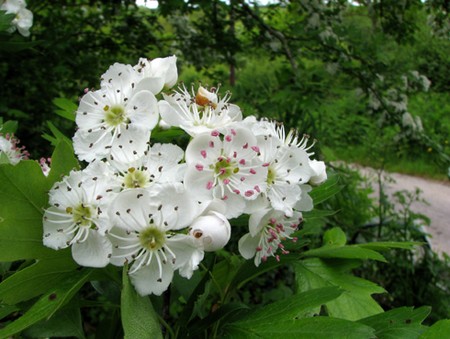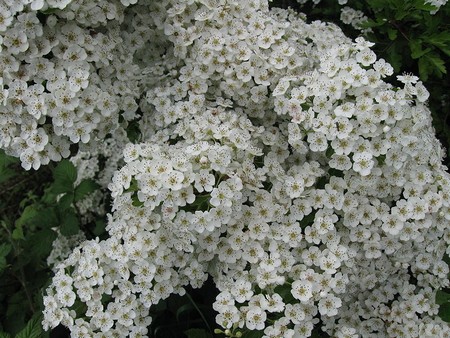This attractive member of the rose family has sweet-scented snow white blossoms covering hedgerows in spring as a herald to summer, and bright red berries in autumn. Almost all parts of the plant have been used in healing since the Middle Ages.
Hawthorn has long been considered a sacred and protecting plant. Sprigs of hawthorn were attached to the cradle of a newborn baby to afford protection against illness and evil influences. Psychics say it can give protection, to lift the spirits and banish melancholy it worn or carried, but said to be unlucky to bring indoors. Spirits and faeries had their meeting place under the hawthorn tree.
Hawthorn has traditionally been connected with May Day customs in the Northern hemisphere where it blooms in Maw The ancient spring festival of May Day was named after the Greek goddess Maia. The girl crowned Queen of the May represents the goddess. The maypole ceremony is symbolic of renewed life, fertility and spring. The maypole represented an axis mundi around which the universe revolves; the tree stripped of its changing foliage symbolizes the changeless centre. The pole is phallic, the ribboned discus at the top representing the feminine principle and the union of the two represents fertility. It was Customary to erect hawthorn trees outside your sweetheart’s house and to decorate porches with hawthorn on Max Day in main parts of Europe.
Hawthorn has been associated with fertility and affairs of the heart since the days of the Ancient Greeks and Romans. At Greek wedding feasts the guests used to carry sprigs of hawthorn to bring happiness and prosperity to the newly married couple. In Rome, the bridegroom would wave a sprig of hawthorn as he led his bride to the nuptial chamber, which was lit with hawthorn torches.
The Christian church re-dedicated the hawthorn, like other sacred trees, to the Virgin Man. Hawthorn was reputedly used for Christ’s crown of thorns and it was one of these thorns, piercing the robin’s breast, that gave the bird his red breast. It was believed for centuries that lightning would never strike a hawthorn tree – lightning was the work of the devil and could not strike a plant that had touched the brow of Christ.
Herbal remedy
Hawthorn is veritably the best remedy for the heart and circulation. The flowers, leaves and berries all act as a wonderful heart tonic and have a vasodilatory effect, opening the arteries and thus improving blood supply to all body tissues. It makes an excellent remedy for high blood pressure, particularly that associated with hardening of the arteries.
Hawthorn can be used to improve poor circulation associated with ageing arteries. It acts to open the coronary arteries, improving blood flow through the heart and softening deposits, allieviating hardening of the arteries which causes angina. It is ideal for all heart conditions, including arrhythmias, palpitations, breathlessness, degenerative heart disease and heart failure.
The berries have an astringent effect and are used for diarrhoea. In addition the leaves, flowers and berries have a relaxant effect in the digestive tract. In the nervous system they relieve stress and anxiety, calming agitation and restlessness, and inducing sleep in insomniacs. They also have a diuretic effect.
Externally, a decoction of the flowers and berries can be used as a lotion for a blotchy complexion and acne rosacea. A decoction of the berries makes an astringent gargle for sore throats and a douche for vaginal discharges.
Homeopathic remedy: Crataegus
Crataegus is also a wonderful heart tonic. It is used for chronic heart disease with extreme weakness, for heart failure that threatens from the slightest exertion, for pain in the heart area, high blood pressure and arteriosclerosis of the elderly. The berries are used in a mother tincture as a heart remedy.
The flower essence
On an emotional level hawthorn is said to work on the heart chakra, opening the heart and enhancing the expression of love. It can he used where there are problems both giving and receiving love. It is a remedy recommended to heal broken hearts, disappointment, anger or bitterness after a tailed love-affair. It eases emotional extremes which would contribute to physical illness such as heart disease.

